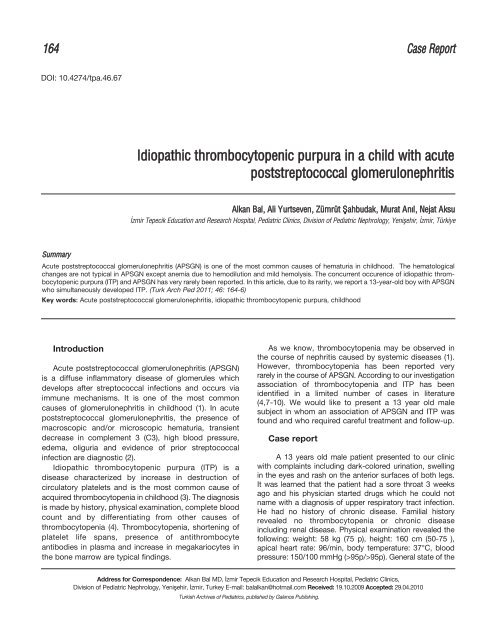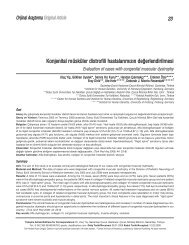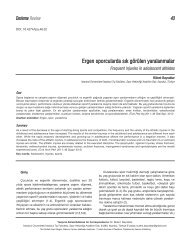Idiopathic thrombocytopenic purpura in a child with acute ...
Idiopathic thrombocytopenic purpura in a child with acute ...
Idiopathic thrombocytopenic purpura in a child with acute ...
You also want an ePaper? Increase the reach of your titles
YUMPU automatically turns print PDFs into web optimized ePapers that Google loves.
116644<br />
DOI: 10.4274/tpa.46.67<br />
SSuummmmaarryy<br />
Introduction<br />
<strong>Idiopathic</strong> <strong>thrombocytopenic</strong> <strong>purpura</strong> <strong>in</strong> a <strong>child</strong> <strong>with</strong> <strong>acute</strong><br />
poststreptococcal glomerulonephritis<br />
Alkan Bal, Ali Yurtseven, Zümrüt fiahbudak, Murat An›l, Nejat Aksu<br />
‹zmir Tepecik Education and Research Hospital, Pediatric Cl<strong>in</strong>ics, Division of Pediatric Nephrology, Yeniflehir, ‹zmir, Türkiye<br />
Acute poststreptococcal glomerulonephritis (APSGN) is one of the most common causes of hematuria <strong>in</strong> <strong>child</strong>hood. The hematological<br />
changes are not typical <strong>in</strong> APSGN except anemia due to hemodilution and mild hemolysis. The concurrent occurence of idiopathic <strong>thrombocytopenic</strong><br />
<strong>purpura</strong> (ITP) and APSGN has very rarely been reported. In this article, due to its rarity, we report a 13-year-old boy <strong>with</strong> APSGN<br />
who simultaneously developed ITP. (Turk Arch Ped 2011; 46: 164-6)<br />
Key words: Acute poststreptococcal glomerulonephritis, idiopathic <strong>thrombocytopenic</strong> <strong>purpura</strong>, <strong>child</strong>hood<br />
Acute poststreptococcal glomerulonephritis (APSGN)<br />
is a diffuse <strong>in</strong>flammatory disease of glomerules which<br />
develops after streptococcal <strong>in</strong>fections and occurs via<br />
immune mechanisms. It is one of the most common<br />
causes of glomerulonephritis <strong>in</strong> <strong>child</strong>hood (1). In <strong>acute</strong><br />
poststreptococcal glomerulonephritis, the presence of<br />
macroscopic and/or microscopic hematuria, transient<br />
decrease <strong>in</strong> complement 3 (C3), high blood pressure,<br />
edema, oliguria and evidence of prior streptococcal<br />
<strong>in</strong>fection are diagnostic (2).<br />
<strong>Idiopathic</strong> <strong>thrombocytopenic</strong> <strong>purpura</strong> (ITP) is a<br />
disease characterized by <strong>in</strong>crease <strong>in</strong> destruction of<br />
circulatory platelets and is the most common cause of<br />
acquired thrombocytopenia <strong>in</strong> <strong>child</strong>hood (3). The diagnosis<br />
is made by history, physical exam<strong>in</strong>ation, complete blood<br />
count and by differentiat<strong>in</strong>g from other causes of<br />
thrombocytopenia (4). Thrombocytopenia, shorten<strong>in</strong>g of<br />
platelet life spans, presence of antithrombocyte<br />
antibodies <strong>in</strong> plasma and <strong>in</strong>crease <strong>in</strong> megakariocytes <strong>in</strong><br />
the bone marrow are typical f<strong>in</strong>d<strong>in</strong>gs.<br />
As we know, thrombocytopenia may be observed <strong>in</strong><br />
the course of nephritis caused by systemic diseases (1).<br />
However, thrombocytopenia has been reported very<br />
rarely <strong>in</strong> the course of APSGN. Accord<strong>in</strong>g to our <strong>in</strong>vestigation<br />
association of thrombocytopenia and ITP has been<br />
identified <strong>in</strong> a limited number of cases <strong>in</strong> literature<br />
(4,7-10). We would like to present a 13 year old male<br />
subject <strong>in</strong> whom an association of APSGN and ITP was<br />
found and who required careful treatment and follow-up.<br />
Case report<br />
A 13 years old male patient presented to our cl<strong>in</strong>ic<br />
<strong>with</strong> compla<strong>in</strong>ts <strong>in</strong>clud<strong>in</strong>g dark-colored ur<strong>in</strong>ation, swell<strong>in</strong>g<br />
<strong>in</strong> the eyes and rash on the anterior surfaces of both legs.<br />
It was learned that the patient had a sore throat 3 weeks<br />
ago and his physician started drugs which he could not<br />
name <strong>with</strong> a diagnosis of upper respiratory tract <strong>in</strong>fection.<br />
He had no history of chronic disease. Familial history<br />
revealed no thrombocytopenia or chronic disease<br />
<strong>in</strong>clud<strong>in</strong>g renal disease. Physical exam<strong>in</strong>ation revealed the<br />
follow<strong>in</strong>g: weight: 58 kg (75 p), height: 160 cm (50-75 ),<br />
apical heart rate: 96/m<strong>in</strong>, body temperature: 37°C, blood<br />
pressure: 150/100 mmHg (>95p/>95p). General state of the<br />
Address for Correspondence: Alkan Bal MD, ‹zmir Tepecik Education and Research Hospital, Pediatric Cl<strong>in</strong>ics,<br />
Division of Pediatric Nephrology, Yeniflehir, ‹zmir, Turkey E-mail: balalkan@hotmail.com Received: 19.10.2009 Accepted: 29.04.2010<br />
Turkish Archives of Pediatrics, published by Galenos Publish<strong>in</strong>g.<br />
CCaassee RReeppoorrtt
TTuurrkk AArrcchh PPeedd 22001111;; 4466:: 116644--66<br />
patient was well and no pathology was found except for<br />
pretibial edema (+) and petechiae on the anterior surfaces<br />
of both tibiae. Laboratory f<strong>in</strong>d<strong>in</strong>gs were as follows: white<br />
blood cells: 6400/mm 3, hemoglob<strong>in</strong>: 9.4 g/dL, MCV: 82 fL,<br />
platelets: 11000/mm 3. Peripheral blood smear revealed rare<br />
solitary, large, irregular thrombocytes and no f<strong>in</strong>d<strong>in</strong>g of<br />
hemolysis <strong>in</strong>clud<strong>in</strong>g helmet cells or fragmented erythrocytes<br />
could be found. Reticulocyte count was found to be<br />
1-2%. Ur<strong>in</strong>alysis revealed the follow<strong>in</strong>g: tea-colored<br />
appearance, pH 5, density 1010, prote<strong>in</strong> (+). On microscopic<br />
exam<strong>in</strong>ation of ur<strong>in</strong>e, hyal<strong>in</strong>e casts and granular<br />
casts were observed along <strong>with</strong> abundant erythrocytes<br />
(80% <strong>with</strong> deformation). Daily ur<strong>in</strong>e output of the patient<br />
was calculated to be 0,4 ml/kg/hour. Biochemical tests<br />
revealed that urea (110 mg/dL) and creat<strong>in</strong><strong>in</strong>e (1.6 mg/dL)<br />
levels were <strong>in</strong>creased and serum C3 level was decreased<br />
(29 mg/dL; N: 90-180 mg/dL). Other basic biochemical<br />
variables were <strong>with</strong><strong>in</strong> normal limits (glucose: 104 mg/dL,<br />
Na: 141 mmol/L, K: 4.2 mmol/L, ALT: 14 U/L, Ca: 9.3<br />
mg/dL). Erythrocyte sedimentation rate (60 mm/hour) and<br />
anti-streptolys<strong>in</strong> O (ASO: 642 IU/mL; N:
116666 Bal et al. APSGN and ITP TTuurrkk AArrcchh PPeedd 22001111;; 4466:: 116644--6666<br />
be caused by splenic breakdown of most autoantibodies<br />
bound to thrombocytes and a lower number of immun<br />
complexes reach<strong>in</strong>g glomerules. However, observation of<br />
a more severe picture of glomerulonephritis <strong>in</strong> the two<br />
cases def<strong>in</strong>ed subsequently and <strong>in</strong> our case caused this<br />
assumption to be debatable (4, 10).<br />
In the recently reported case from Hawaii (4) and <strong>in</strong><br />
our case, <strong>in</strong>travenous immunglobul<strong>in</strong> (IVIG) treatment<br />
<strong>in</strong>stead of steroid was adm<strong>in</strong>istered <strong>in</strong> contrast to other<br />
cases. Thrombocyte count returned to normal limits <strong>with</strong><br />
IVIG treatment <strong>in</strong> our case and renal function improved<br />
fully <strong>with</strong> <strong>in</strong>travenous furosemide and supportive<br />
treatment. In all cases, laboratory and cl<strong>in</strong>ical f<strong>in</strong>d<strong>in</strong>gs<br />
except for microscopic hematuria returned to normal <strong>in</strong><br />
1-3 months (7-9).<br />
Anthony et al.(4) noted that association of APSGN<br />
and ITP may be specific for populations <strong>with</strong> a high<br />
<strong>in</strong>cidence of diseases <strong>in</strong>clud<strong>in</strong>g <strong>acute</strong> rheumatic fever<br />
(ARA) where immun reaction follow<strong>in</strong>g streptococcal<br />
<strong>in</strong>fection occurs widely. However, the fact that cases <strong>in</strong> the<br />
literature come from different regions <strong>in</strong>clud<strong>in</strong>g Arabian<br />
Pen<strong>in</strong>sula, Canada, Japan, Macedonia, the Philipp<strong>in</strong>es and<br />
Turkey causes this assumption also to be debatable.<br />
Consequently, the etiology of the association of<br />
APSGN and ITP which we def<strong>in</strong>ed as different cl<strong>in</strong>ical<br />
states and for which we planned different treatments<br />
rema<strong>in</strong>s debatable. However, as the number of cases<br />
reported <strong>in</strong> the literature <strong>in</strong>creases, a dist<strong>in</strong>ct cl<strong>in</strong>ical state<br />
might be def<strong>in</strong>ed under the name of association of<br />
glomerulonephritis and thrombocytopenia follow<strong>in</strong>g<br />
streptococcal <strong>in</strong>fection.<br />
Conflict of <strong>in</strong>terest: None declared<br />
References<br />
1. Davis ID. <strong>Idiopathic</strong> Thorombocytopenic Purpura. In: Behrman<br />
RE, Kliegman RM, Jenson HB, (eds). Textbook of Pediatrics.<br />
18th ed. Philadelphia: WB Saunders Company, 2007: 2082.<br />
2. Nordstrand A, Norgren M, Holm SE. Pathogenic mechanism of<br />
<strong>acute</strong> post-streptococcal glomerulonephritis. Scand J Infect<br />
Dis 1999; 31: 523-37.<br />
3. Bolton-Maggs PH. <strong>Idiopathic</strong> <strong>thrombocytopenic</strong> <strong>purpura</strong>. Arch<br />
Dis Child 2000; 83: 220-2.<br />
4. Guerrero AP, Musgrave JE, Lee EK. Immune globul<strong>in</strong>responsive<br />
thrombocytopenia <strong>in</strong> <strong>acute</strong> post-streptococcal<br />
glomerulonephritis: report of a case <strong>in</strong> Hawai'i. Hawaii Med J<br />
2009; 68: 56-8.<br />
5. Qasim ZA, Partridge RA. Thrombotic <strong>thrombocytopenic</strong><br />
<strong>purpura</strong> present<strong>in</strong>g as bilateral flank pa<strong>in</strong> and hematuria: a case<br />
report. J Emerg Med 2001; 21: 15-20.<br />
6. Scott J P. Acute poststreptococcal glomerulonephritis. In:<br />
Behrman RE, Kliegman RM, Jenson HB, (eds). Textbook of<br />
Pediatrics. 18th ed. Philadelphia: WB Saunders Company:<br />
2007: 2173.<br />
7. Kaplan BS, Esselt<strong>in</strong>e D. Thrombocytopenia <strong>in</strong> patients <strong>with</strong><br />
<strong>acute</strong> post-streptococcal glomerulonephritis. J Pediatr 1978;<br />
93: 974-5.<br />
8. Rizkallah MF, Ghandour MH, Sabbah R, Akhtar M. Acute<br />
<strong>thrombocytopenic</strong> <strong>purpura</strong> and poststreptococcal <strong>acute</strong><br />
glomerulonephritis <strong>in</strong> a <strong>child</strong>. Cl<strong>in</strong> Pediatr 1984; 23: 581-3.<br />
9. Muguruma T, Koyama T, Kanadani T, Furujo M, Shiraga H,<br />
Ichiba Y. Acute thrombocytopenia associated <strong>with</strong> poststreptococcal<br />
<strong>acute</strong> glomerulonephritis. J Paediatr Child Health<br />
2000; 36: 401-2.<br />
10. Tasic V, Polenakovic M. Thrombocytopenia dur<strong>in</strong>g the course<br />
of <strong>acute</strong> poststreptococcal glomerulonephritis. Turk J Pediatr<br />
2003; 45: 148-51.<br />
11. Toprak D, Demirdal T, Aflç› Z, Orhan S, Çet<strong>in</strong>kaya Z, Demirtürk N.<br />
Sa¤l›kl› okul çocuklar›nda nazofarenksde A grubu beta hemolitik<br />
streptokok tafl›y›c›l›¤›. Düzce T›p Fak Derg 2008; 2: 26-9.





